2-DE PROTEOME MAPS OF AMARANTH AND BUCKWHEAT SEEDS
Keywords:
Amaranth, buckwheat, 2-DE protein maps, celiac diseaseAbstract
Our work was focus on amaranth (Amaranthus sp.) cv. Plaisman and buckwheat (Fagopyrum Mill.), cv. Pyra proteome, which was analysed by 2-D electrophoresis. We found similarity between the chemical properties proteins of pseudocereals amaranth and buckwheat. Image analysis showed a higher number of spots on 2-DE map of buckwheat in comparison to amaranth. Some similarities were in protein spots at approximately 21,000 Da, pI 7 and strip of protein spots in range of pI 8-10, 21,000 Da. The buckwheat 2-DE map shows spots of protein with higher intensity in the region ranging from 30-45,000 Da, pI 5-6 as well as highly abundant protein spots from visible at 36-40,000 Da, pI 8-9. Protein maps showed that the pseudocereals do not content storage proteins, which indicates that they are suitable as a replacement for cereals for people with celiac disease.Downloads
Download data is not yet available.
Downloads
Published
2014-02-01
How to Cite
Gálová, Z., PálenÄárová, E., Chňapek, M., & Balažová, Želmira. (2014). 2-DE PROTEOME MAPS OF AMARANTH AND BUCKWHEAT SEEDS. Journal of Microbiology, Biotechnology and Food Sciences, 3(special issue 2 (Biotechnology), 74–76. Retrieved from https://office2.jmbfs.org/index.php/JMBFS/article/view/7626
Issue
Section
Biotechnology
License
Copyright (c) 2014 Zdenka Gálová, Eva PálenÄárová, Milan Chňapek, Želmira Balažová

This work is licensed under a Creative Commons Attribution 4.0 International License.
All papers published in the Journal of Microbiology, Biotechnology and Food Sciences are published under a CC-BY licence (CC-BY 4.0). Published materials can be shared (copy and redistribute the material in any medium or format) and adapted (remix, transform, and build upon the material for any purpose, even commercially) with specifying the author(s).

